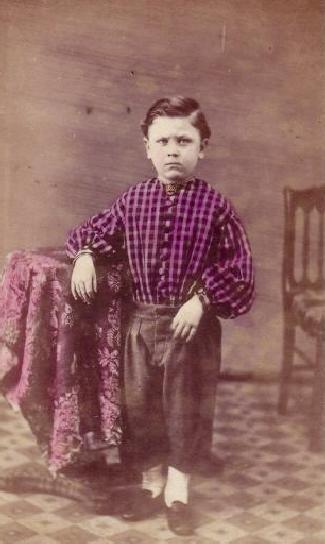
Color Photograph Portrait Tinting: Accuracy

Figure 1.--This is a Civil War era CDV, perhaps taken during the War, perhaps a few year after the War in the 1860s. One question we have about these tinted portraits is the accuracy of the color reproduction. Here the stydio has used only one shade, a kind og magenta, on both the boy's shirt and table drapeing. We arenot at all sure that this actually reflected the color of the boy's shirt, but we would guess that is was a brightly colored check--perhaps red.
|
|
We notice a variety of colors in these tinted portraits. Some look garish and unrealistc with color just spread over a garment or textile. Other portraits are much more carefully done and look realistic.
The colors in some of these tinted portrait look plausible in these photgraphs, but we are not sure how the color information was conveyed to the painter who would have done his or her work long the subjects had left the studio. This same color tinting or painting process was also used on a much larger scale to produce commercial postcards. Here the colors applied often had nothing to do with the colors of the clothes the children wore. We think the portrait tinting may have been more accurate. We suspect that customers would have wanted their portraits to look something like their actual clothes, but we can notnot yet confirm this with period sources. It is of course important to HBC because the tinted photographs potentially offer information on the color of clothes worn in the 19th and early 20th century.
We notice a variety of colors in these tinted portraits. Some look garish and unrealistc with color just spread over a garment or textile. They seem brighter colors than children may have worn. Other portraits are much more carefully done and look realistic with the painting quite intricate. The colors in some of these tinted portrait look very plausible in these portraits.
Process
We are not sure how the color information was conveyed to the painter who would have done his or her work long the subjects had left the studio. Notes could have been taken. And some studios offered to provide portrais while the custmer waited in the studio. So I supose some of these portraits could have been done while the customer waited.
Post Cards
This same color tinting or painting process was also used on a much larger scale to produce commercial postcards. Here the colors applied often had nothing to do with the colors of the clothes the children wore. We think the portrait tinting may have been more accurate.
Accuracy
We suspect that customers would have wanted their portraits to look something like their actual clothes, but we can not yet confirm this with period sources.
Importance
It is of course important to HBC because the tinted photographs potentially offer information on the color of clothes worn in the 19th and early 20th century.
HBC

Navigate the Boys' Historical Clothing Web Site:
[Return to:Main photograph tinting page]
[Return to:Main photography page]
[Introduction]
[Activities]
[Biographies]
[Chronology]
[Clothing styles]
[Countries]
[Girls]
[Bibliographies]
[Contributions]
[Essays]
[FAQs]
[Glossaries]
[Images]
[Links]
[Registration]
[Tools]
[Boys' Clothing Home]
Navigate the Boys' Historical Clothing Web Site:
[Return to the U.S. 19th century shirt chronology]
[Sailor suits]
[Sailor hats]
[Buster Brown suits]
[Eton suits]
[Rompers]
[Shirts and collars]
[Button-on clothing]
[Tunics]
[Smocks]
[Pinafores]
Created: 2:58 PM 9/7/2007
Last updated: 7:11 PM 9/7/2007



